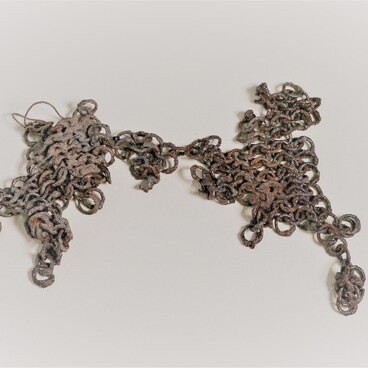A crucible is a container for firing, heating, and melting materials. The term is derived from the German word “tiegel” meaning “pot”. The oldest crucibles found date back to the 11th — 10th centuries B.C.
In the old times, metal products were brought to the Salym District from Ural, Altai, and Sayan, where the centers of metallurgy had already formed. Copper, bronze, and, later, ironware was highly valued by the ancient peoples of Salym: when it fell into disrepair, it was melted down rather than thrown away. Scientists discovered a large number of metal items in cults and burial complexes — the most valuable items were usually brought there. Later, the local population mastered the process of metal processing and smelting from scrap metal.
A new archaeological culture — the Kulay culture — existed on the territory of the Salym region from about the end of the 3rd century B.C. to the beginning of the 3rd century A.D. Scientists find metal goods of the earliest origins in the area where the Kulay people settled. By the turn of the era, metal had become the main material used in all spheres of life and, above all, for making tools, weapons, and cult objects.
The ceramic crucibles from the archeological collection of the Museum of the Ob River were found during the studies of Kulay bronze casting complexes on the territory of Syroy Agan 6 settlement. Initially, they were separate fragments, from which whole vessels were later glued together. All three crucibles, presented in the hall “Ancient History”, are restored, i.e. rebuilt from pieces.
One of the pieces contains traces of gray color, indicating limited access to oxygen in the smelting furnace, and the cracked edge is evidence of a very high temperature. The researchers speculate that the gray-colored fragments were not used to smelt metal. Perhaps they were put under the crucibles during heating. By pressing the fragments into the sand before heating, it was possible to set the necessary gap between the ground and the bottom of the crucible, in which hot coals were placed.
In the old times, metal products were brought to the Salym District from Ural, Altai, and Sayan, where the centers of metallurgy had already formed. Copper, bronze, and, later, ironware was highly valued by the ancient peoples of Salym: when it fell into disrepair, it was melted down rather than thrown away. Scientists discovered a large number of metal items in cults and burial complexes — the most valuable items were usually brought there. Later, the local population mastered the process of metal processing and smelting from scrap metal.
A new archaeological culture — the Kulay culture — existed on the territory of the Salym region from about the end of the 3rd century B.C. to the beginning of the 3rd century A.D. Scientists find metal goods of the earliest origins in the area where the Kulay people settled. By the turn of the era, metal had become the main material used in all spheres of life and, above all, for making tools, weapons, and cult objects.
The ceramic crucibles from the archeological collection of the Museum of the Ob River were found during the studies of Kulay bronze casting complexes on the territory of Syroy Agan 6 settlement. Initially, they were separate fragments, from which whole vessels were later glued together. All three crucibles, presented in the hall “Ancient History”, are restored, i.e. rebuilt from pieces.
One of the pieces contains traces of gray color, indicating limited access to oxygen in the smelting furnace, and the cracked edge is evidence of a very high temperature. The researchers speculate that the gray-colored fragments were not used to smelt metal. Perhaps they were put under the crucibles during heating. By pressing the fragments into the sand before heating, it was possible to set the necessary gap between the ground and the bottom of the crucible, in which hot coals were placed.

